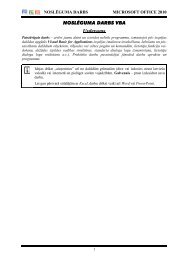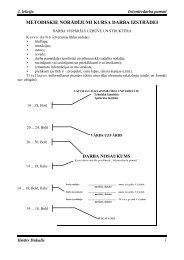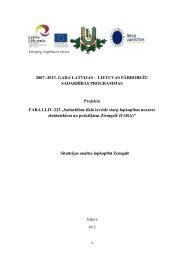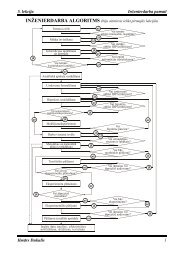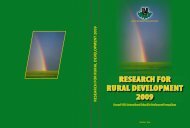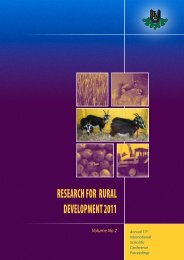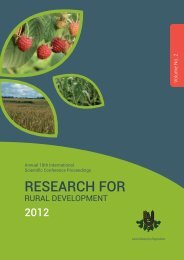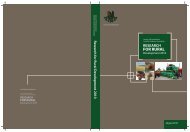FOOD SCIENCESThe suitability of different ROWANBERRY CULTIVARSfor production of fruit marmaladeElga Berna, Solvita Kampuse, Evita StraumiteLatvia University of Agriculturee-mail: elga@tvnet.lvAbstractThe rowanberries (Sorbus aucuparia L.) are small orange-red fruits of a rowan tree and belong to the family Rosaceae.These berries have been described as an important source of flavonoids, and their antioxidant activity affects reactiveoxygen species and lipid peroxidation; therefore they are suitable for production of health-food products. The ripewild rowanberries have traditionally been used for jellies and jams, but their use as a food ingredient has been lesspopular because of their bitter taste. Sweeter and less astringent than wild rowanberries are different cultivars ofsweet rowanberries and hybrids with other species. The aim of the current research was to determine physical andchemical parameters and sensory properties of rowanberry marmalades. The experiments were carried out in theFaculty of Food Technology of Latvia University of Agriculture. The purees of wild rowanberry and six differentrowanberry cultivars were chosen for the production of marmalades. Chemical, physical and sensory indices ofthe product – moisture, total carotenoids, tannins, colour, hardness and intensity of sensory properties (flavour,colour, bitterness) – were determined as quality indicators. The results showed large variability in the physical andchemical parameters between the marmalades of different rowanberry cultivars and hybrids. The sensory evaluationof marmalades from rowanberry cultivars ‘Moravica’, ‘Mitchurinskaya krasnaya’, ‘Sorbinka’ and hybrid ofrowanberry × hawthorn ‘Granatnaya’ showed that the degree of liking was from “neither like nor dislike” to “likemoderately”, and marmalades from wild rowanberry, S. aucuparia var. sibirica and hybrid of rowanberry × pear‘Alaya Krupnaya’ – from “dislike moderately” to “dislike slightly”.Key words: Rowanberry marmalade, carotenoids, tannins, colour, hardness, sensory evaluation.IntroductionThe rowanberries (Sorbus aucuparia L.) belongto the subfamily Maloideae of the family Rosaceaeand their berries have been promoted as a health-foodor can be a source for health-promoting components.The ripe wild rowanberries are picked in the autumnand they are eatable, but very tart in flavour and tastealthough contain lots of sugar. Rowanberries havebeen traditionally used to make purees, juices or wineand they make an excellent jelly because of their highamount of pectin, but their use as a food ingredienthas been less popular because of their bitter taste(Hukkanen et al., 2006; Poyrazoğlu, 2004; Gough,2008; Wang, 2007).Sweeter and less astringent than wild rowanberriesare different cultivars of sweet rowanberries andhybrids with other species. The first sweet rowanberryclones were selected in the Sudety mountain area, inthe current Czech Republic area in the 19th century. Abreeding program for sweet rowanberries was startedby Michurin in Russia at the beginning of 20th century,resulting in interesting hybrids of the rowanberry(Sorbus aucuparia L.) with the Aronia, Malus,Mespilus, or Pyrus species. Sweet rowanberries havebeen bred particularly for northern conditions andhave shown excellent winter-hardiness in Russia andFinland (Hukkanen et al., 2006). According to foodcomposition and nutrition tables, sweet rowanberryS. aucuparia L. var. edulis contains 1600–2420 mg oforganic acids per 100 g of edible portion, 98 mg ofvitamin C per 100 g, and 2.5 mg of total carotenoidsper 100 g (Souci et al., 2008). Comparison of the dataobtained to wild rowanberries sugar content indicatedthat cultivars of the sweet rowanberries were reallythe sweetest – sugar content in their fruits wereconsiderably 1.2–2.1 times higher (Navys, 2001).The content of reducing sugars (i.e. total amount ofglucose and fructose) ranged from 5 to 18 g 100 g -1(Souci et al., 2008, Eder et al., 1991). The content ofsorbitol, a sweetening agent that diabetics can tolerate,was high and varied from 3.5 to 12 mg 100 g -1 (Ederet al., 1991; Стрельцина et al., 2010).Sweets constitute the group of food for whichhuman beings have always had some inbornpreferences because the majority of sweet fruits oredible parts of plants found in the natural environmentare not poisonous. The group of sweets includeshoney, candies, jellies and marmalades, candied fruits,sweets made of cacao, and other (Borawska, 2007).Historically, jams and jellies may have originatedas an early effort to preserve fruit for consumptionin the off-season. Processing of different fruits intojuice, marmalade or jam is important for insuring offruits during all year. Jellies, jams and marmalades areprimary distinguished by the form from which their fruitis incorporated. Marmalades are basically jellies withfruit purée and sugar-acid-pectin gel or low-methoxylpectin-calcium gels. Pectin is traditionally used in awide range of fruit-based products in which it acts as athickeners agent (Figuerola, 2007; Grujić et al., 2010;Baker et al., 1996; Willats et al., 2006). Marmalade isa spreadable preparation made from pulp, slurry, juice,aqueous extracts or peels of citrus fruits and sugars.The product has to contain at least 60% by weight ofResearch for Rural Development 2012109
THE SUITABILITY <strong>OF</strong> DIFFERENT ROWANBERRY CULTIVARSFOR PRODUCTION <strong>OF</strong> FRUIT MARMALADEElga Berna, Solvita Kampuse, Evita Straumitesoluble solids. The addition of fruit pectin and starchsyrup is customary. For the production of marmalade,the fresh fruits or intermediary products, such as fruitpulps or slurries, are boiled with the addition of sugar.Other ingredients (gelling agents, starch syrup andacids) are added before the thickening is completedby boiling (Belitz, 2009).Berries are one of the most suitable fruits forprocessing into jams and jellies because of theirquality, acidity, colour, normally high pectin content,flavour, and aroma. If the fruit does not have enoughpectin, commercial pectin has to be used, where amixture of the required pectin with a similar portion ofsugar should be added after the concentration processto avoid heat damage to the pectin molecules. Sugarand other minor ingredients help to develop textureof jams and marmalades because of the formationof a gel between sugars and pectin substances alongwith fruit acidity. The proportions of fruit and sugarfor mixtures should not be less than 45–47 parts byweight of fruit to each 55 parts by weight of sugar(Grujić et al., 2010; Figuerola, 2007).Acidity of the fruit or its pH value is one of themost important factors in jam process. If the fruit doesnot have enough acid, a controlled amount of organicacid, such as citric or malic acid, sodium citrate orother is added to reach the required pH to producegel formation. For gel formation and its stabilityit is important to insure optimal pH range – 2.5-4.5(Figuerola, 2007; Javanmard and Endan, 2010; Grujićet al., 2010; Willats et al., 2006).The purpose of the current research was todetermine physical and chemical parameters andsensory properties of fruit marmalades made fromsweet rowanberries.Materials and MethodsExperimental designThe research was carried out at the Faculty ofFood Technology, Latvia University of Agriculture, in2011. The object of the research was fruit marmaladefrom berries of different rowanberry cultivars grownin Latvia. The rowanberries were picked in the PureHorticultural Research centre; description of usedrowanberry cultivars is given in Table 1. The fruitmarmalades were made from rowanberry purees.The rowanberry purees were made from frozen andthawed fruits that were scrubbed through sieve. Themass, mixed with sugar (sucrose – 23.5% from thetotal amount of product), was heated till 85–90 °C toevaporate part of the water, adding 5.0% pectin (Genpectin LM-104-AS powder) mixed with part of sugar.The samples of rowanberry marmalade were filled inpolypropylene boxes and stored three days at roomtemperature (22±2 °C) for ripening and thickening.Dimensions of one piece of marmalade on averagewas 90×70×20 mm, and mass – 100±5 g.Seven samples of rowanberry marmalades wereprepared in this research. Chemical, physical andsensory analyses of the products – moisture content,pH, total carotenoids and tannins, colour L*a*b*values, hardness and intensity of sensory properties(flavour, colour, bitterness) – were determined asquality indicators.MethodsThe moisture content of fruit marmalade wasdetermined with an oven method. The marmaladesamples (10 g) were dried at 97 °C overnight (Mattilaet al., 2006). For analysis, vacuum drying oven VD53(Binder) and analytical scales BP-210s (Sartorius)The description of rowanberry cultivars used for researchTable 1RowanberrycultivarSort characteristicDescription of fruitsSorbus aucuparia Wild rowanberry Orange or bright red coloured fruitswith bitter tasteS. aucuparia var.sibiricaVariety of S. aucupariaOrange coloured fruits with bittertaste‘Moravica’ Moravian group variety of S. aucuparia Orange-red coloured fruits with sweetand sour taste‘Sorbinka’ Moravian group variety of S. aucuparia Orange coloured fruits with sweet andsour taste‘Mitchurinskayakrasnaya’Variety of S. aucupariaDark red coloured fruits with sweetand sour taste‘Granatnaya’ Hybrid of rowanberry × hawthorn (Sorbus Dark red or brown coloured fruitsaucuparia × Crataegus sanguinea Pallas) with sweet and sour taste‘Alaya Krupnaya’ Hybrid of rowanberry × pear (Sorbus aucuparia Bright red-brown coloured fruits with× Pyrus sp. × Sorbus aucuparia var. moravica) littlebit bitter taste110 Research for Rural Development 2012



